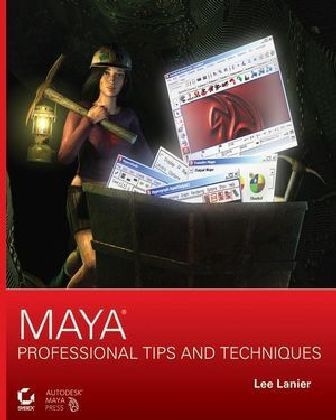
Maya Professional Tips and Techniques
John Wiley & Sons Ltd (Verlag)
978-0-470-10740-9 (ISBN)
- Titel ist leider vergriffen;
keine Neuauflage - Artikel merken
Lee Lanier is a professional animator and teacher who has created digital special effects for such films as The Santa Clause and Mortal Kombat. He was a senior animator for modeling and lighting on Antz and Shrek and has produced and directed the short films Millennium Bug, Mirror, Day Off The Dead, Weapons of Mass Destruction, and 13 Ways to Die at Home. He has taught advanced Maya classes at several schools, including the Art Institute of Las Vegas. His work can be seen at beezlebugbit.com. Lee is the author of Advanced Maya Texturing and Lighting (Sybex).
Introduction. Chapter 1 Customization and MEL Scripting. Resetting to Factory/Swapping Prefs Files. Creating Custom Shelf Icons. Building a Simple MEL Window. Building an Intermediate MEL Window.7 Retrieving Values from Fields. Creating an Autosave MEL Script.9 Timing with timerX and Killing with scriptJob. Creating Your Own Paint Effects Brushes. Customizing a Tube Brush. Creating Notes for Your Fellow Animators. Passing Information to Files. Reading Text Files. Industry Tip: Creating an "Expert Mode" MEL Script. Chapter 2 Modeling. Breaking Up NURBS Surfaces. Important Rules for NURBS Modeling. Cleaning Up NURBS Surfaces with Attach and Detach. Closing Holes in NURBS Objects. Building a NURBS Gear. Building a NURBS Eye. Mapping the Iris. Cleaning Up Imported Polygons. Industry Tip: Building a Polygon Head by Extruding Edges. Industry Tip: Adjusting the Maya Grid for Linear Units. Chapter 3 History, Scripting, and Animation. Deleting Select History in the Hypergraph. Using Variables within Expressions or MEL Scripts. Choosing between Local and Global Variables. Driving Vehicle Wheels and Bike Pedals. Massaging Curves in the Graph Editor. Removing Pops. Introducing Float. Mimicking Motion with Curves. Wilting a Paint Effects Flower. Creating Realistic Eye Movement. Animating Realistic Camera Moves. Limiting Camera Motion. Fine-Tuning Camera Stops. Matching the Camera to the Subject Matter. Chapter 4 Dynamics, Particles, and the Ocean System. Driving a Boat through an Ocean. Creating an Ocean Wake. Building a Dynamic Chain. Filling a Water Glass with Particles. Swapping Solid Geometry for Particles. Animating Gelatin with a Soft Body. Generating Swarms with Goals. Industry Tip: Scattering Geometry with Instanced Particles and Expressions. Adding Additional Variation to Instanced Geometry. Offsetting Animation within an Instancer. Chapter 5 Character Rigging. Resetting Bind Poses with dagPose. Creating a Poor Man's Foot and Leg Rig. Controlling the Leg and Foot Rig. Setting Up an Easy Spine Controller. Picking Up a Prop with a Constraint. Using Blended Wire Deformers for Facial Rigging. Weighting a Head with the Component Editor. Using the Paint Skin Weights Tool. Preventing Cluster Drift. Creating a Spline IK Spine. Industry Tip: Creating an Advanced Arm Rig. Chapter 6 Texturing. Building a Texture Library. Choosing Texture Bitmaps. Exporting Maya Shaders. Fractals and Noise in Math, Nature, and Maya. Combining Generic Bitmaps in Maya. Coloring Particles Individually. Coloring Software-Rendered Particles. Texturing Paint Effects Tubes. Controlling the Paint Effects Texture. Industry Tip: Rendering ZBrush Displacement Maps in Maya. Chapter 7 Lighting. Mastering 1-, 2-, and 3-point Lighting. Adding the Second Light. Adding the Third Light. Mastering Naturalistic Lighting. Setting the Mood with Light Color and Position. Creating Stylistic Lighting. Setting Up Believable Lamplight. Forcing Decay on Directional and Ambient Lights. Industry Tip: Unusual Lighting Techniques. Producing Quality Depth Map Shadows. Chapter 8 Rendering. Splitting Up Renders per Object. Rendering Interlocking Characters in Separate Passes. Splitting Up Renders per Shading Component. Rendering Lone Shadows. Rendering Multiple Passes with the Render Layer Editor. Mastering Render Layer Editor Intricacies. Avoiding Raytraced "Black Pits." Rendering a Wireframe for Your Reel. Rendering a Wireframe with the Hardware Render Buffer. Rendering a Wireframe with a Custom Shader. General Rendering Tips for Your Reel. Chapter 9 Advanced Rendering Techniques. Rendering OpenEXR and .hdr Images with mental ray. Viewing HDR Images. Texturing with HDR Images. Previewing HDR Images in the Render View Window. Rendering Super-White Values with mental ray. Choosing Between 16-Bit and HDR Formats. Compositing 16-Bit and HDR Images. Lighting with LDR and HDR Images. Importing ZBrush Normal Maps. Normal Mapping in Maya. Normal Mapping with the Transfer Maps Window. Linking and Unlinking Shadows. Chapter 10 Demo Reels and Project Work Flow. Adding to Your Demo Reel. Rendering Models for Your Reel. Preparing Animation for Your Reel. Editing and Outputting Your Demo Reel. Calibrating Your Monitor. Creating 3D on Multiple Machines. Setting Up a Render Farm. Sharing Texture Libraries. Estimating Project Requirements. Industry Tip: Animation Project Management. Prepping Animation for Video. Prepping Animation for 35mm Film. Finding an Audience for a 3D Short Film. Distributing on the Internet. Screening at Film Festivals. Index.
| Erscheint lt. Verlag | 2.3.2007 |
|---|---|
| Verlagsort | Chichester |
| Sprache | englisch |
| Maße | 201 x 253 mm |
| Gewicht | 706 g |
| Einbandart | Paperback |
| Themenwelt | Informatik ► Grafik / Design ► Film- / Video-Bearbeitung |
| Informatik ► Grafik / Design ► Maya | |
| ISBN-10 | 0-470-10740-5 / 0470107405 |
| ISBN-13 | 978-0-470-10740-9 / 9780470107409 |
| Zustand | Neuware |
| Informationen gemäß Produktsicherheitsverordnung (GPSR) | |
| Haben Sie eine Frage zum Produkt? |
aus dem Bereich


